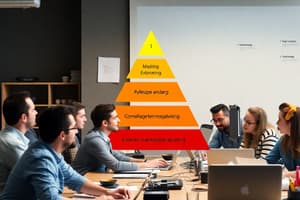Podcast
Questions and Answers
What are tangible rewards primarily associated with?
What are tangible rewards primarily associated with?
- Praise and recognition
- Salary increases and bonuses (correct)
- Job security and safety
- Work conditions and relationships
How is Herzberg's Two-Factor Theory different from Maslow's Hierarchy of Needs?
How is Herzberg's Two-Factor Theory different from Maslow's Hierarchy of Needs?
- It emphasizes workplace motivation over general human needs. (correct)
- It includes only psychological aspects.
- It has a sequential structure of needs.
- It focuses solely on biological needs.
Which example aligns with Maslow's self-actualization level?
Which example aligns with Maslow's self-actualization level?
- Creativity and personal growth (correct)
- Salary increase
- Team recognition
- Job security
What might be a negative effect of not addressing employee motivation?
What might be a negative effect of not addressing employee motivation?
Which needs must be addressed first in Maslow's hierarchy?
Which needs must be addressed first in Maslow's hierarchy?
What is an example of a hygiene factor in Herzberg's Two-Factor Theory?
What is an example of a hygiene factor in Herzberg's Two-Factor Theory?
What is a key component of job satisfaction according to motivational theories?
What is a key component of job satisfaction according to motivational theories?
Which of the following describes an intrinsic motivator according to Herzberg?
Which of the following describes an intrinsic motivator according to Herzberg?
What is a potential criticism of Maslow's Hierarchy of Needs?
What is a potential criticism of Maslow's Hierarchy of Needs?
Which motivation theory emphasizes the balance between hygiene factors and motivation factors?
Which motivation theory emphasizes the balance between hygiene factors and motivation factors?
What outcome does a successful manager achieve by understanding employee motivation?
What outcome does a successful manager achieve by understanding employee motivation?
What does the hygiene factor represent in Herzberg's motivation theory?
What does the hygiene factor represent in Herzberg's motivation theory?
What criticism has been leveled against Maslow's Hierarchy of Needs?
What criticism has been leveled against Maslow's Hierarchy of Needs?
In Herzberg's theory, which scenario represents the 'worst case' situation?
In Herzberg's theory, which scenario represents the 'worst case' situation?
What might a manager do if an employee has high motivation but lacks hygiene?
What might a manager do if an employee has high motivation but lacks hygiene?
Which aspect of Maslow's theory focuses on interpersonal relationships?
Which aspect of Maslow's theory focuses on interpersonal relationships?
Which group of people is suggested to be most successful in the marshmallow challenge?
Which group of people is suggested to be most successful in the marshmallow challenge?
What effect would a reward of ¥50,000 likely have on participants in the marshmallow challenge?
What effect would a reward of ¥50,000 likely have on participants in the marshmallow challenge?
What is the definition of 'psychological safety' according to the content?
What is the definition of 'psychological safety' according to the content?
What factor is crucial for building high-performing teams, as mentioned in the content?
What factor is crucial for building high-performing teams, as mentioned in the content?
In addition to performance, what aspect does Google aim to foster in its teams?
In addition to performance, what aspect does Google aim to foster in its teams?
What aspect of team members' experiences does psychological safety aim to improve?
What aspect of team members' experiences does psychological safety aim to improve?
When group members feel they are not cared for, what is likely to occur?
When group members feel they are not cared for, what is likely to occur?
What is a common theme reflected in the story of Rudolph the Red-Nosed Reindeer?
What is a common theme reflected in the story of Rudolph the Red-Nosed Reindeer?
What is a primary goal of encouraging open communication within a team?
What is a primary goal of encouraging open communication within a team?
How should a leader respond to mistakes to foster psychological safety?
How should a leader respond to mistakes to foster psychological safety?
Which statement best reflects the value of promoting inclusivity in a team?
Which statement best reflects the value of promoting inclusivity in a team?
What is the advantage of supporting risk-taking and innovation in a team environment?
What is the advantage of supporting risk-taking and innovation in a team environment?
Which of the following phrases is NOT useful in promoting a psychologically safe environment?
Which of the following phrases is NOT useful in promoting a psychologically safe environment?
What is the effect of actively inviting team members' perspectives?
What is the effect of actively inviting team members' perspectives?
What is a key characteristic of constructive responses to mistakes?
What is a key characteristic of constructive responses to mistakes?
Why is it important for team members to feel that their ideas are valued?
Why is it important for team members to feel that their ideas are valued?
Flashcards
Maslow's Hierarchy of Needs
Maslow's Hierarchy of Needs
A psychological theory that suggests human needs are arranged in a hierarchy, with basic needs at the bottom and higher needs at the top. Basic needs must be met before individuals can strive for higher needs.
Physiological Needs
Physiological Needs
The most basic level of needs in Maslow's hierarchy, including physiological requirements for survival such as air, water, food, and sleep.
Safety Needs
Safety Needs
The second level of needs in Maslow's hierarchy, involving safety and security, such as protection from harm, stability, and order.
Social Needs
Social Needs
Signup and view all the flashcards
Esteem Needs
Esteem Needs
Signup and view all the flashcards
Self-Actualization Needs
Self-Actualization Needs
Signup and view all the flashcards
Herzberg's Two-Factor Theory
Herzberg's Two-Factor Theory
Signup and view all the flashcards
Hygiene Factors
Hygiene Factors
Signup and view all the flashcards
Prototype
Prototype
Signup and view all the flashcards
Orienting
Orienting
Signup and view all the flashcards
Jockeying
Jockeying
Signup and view all the flashcards
Gingerly
Gingerly
Signup and view all the flashcards
Ta-da
Ta-da
Signup and view all the flashcards
Psychological Safety
Psychological Safety
Signup and view all the flashcards
Team Building
Team Building
Signup and view all the flashcards
Story Time Share
Story Time Share
Signup and view all the flashcards
Tangible Rewards
Tangible Rewards
Signup and view all the flashcards
Intangible Rewards
Intangible Rewards
Signup and view all the flashcards
Good Manager
Good Manager
Signup and view all the flashcards
Motivators
Motivators
Signup and view all the flashcards
Marshmallow Challenge
Marshmallow Challenge
Signup and view all the flashcards
Psychologically Safe Environment
Psychologically Safe Environment
Signup and view all the flashcards
Creating a Psychologically Safe Environment
Creating a Psychologically Safe Environment
Signup and view all the flashcards
Promoting Inclusivity
Promoting Inclusivity
Signup and view all the flashcards
Responding Constructively to Mistakes
Responding Constructively to Mistakes
Signup and view all the flashcards
Encouraging Open Communication
Encouraging Open Communication
Signup and view all the flashcards
Supporting Risk-Taking and Innovation
Supporting Risk-Taking and Innovation
Signup and view all the flashcards
Actively Inviting Perspectives
Actively Inviting Perspectives
Signup and view all the flashcards
Useful Phrases for Psychological Safety
Useful Phrases for Psychological Safety
Signup and view all the flashcards
Study Notes
Test #2 Information
- Introductory Management Test #2
- 10 multiple choice questions
- Study the slides and videos for preparation.
- Test date: Friday, Dec 20
Week 7 Topics
- Personality test
- SMART Goals
SMART Management
- Define key task aims using
SMARTobjectives. SMARTstands for: Specific, Measurable, Achievable, Realistic, and Time-based.- Objectives are vital for ensuring tasks stay on track.
- Effective objectives define the direction of the company.
- SMART planning is practical for everyday tasks.
- Objectives do not need to meet all 5 criteria to be effective. The more criteria met, the "smarter" it becomes.
- Action plans are critical for executing objectives.
Goals vs. Objectives
- Goals are conceptual, relating to the bigger picture, and often continuous and long-term.
- Objectives are specific steps, and often quantifiable/measurable, providing morale boost.
- Objectives support long term goals.
SMART Planning Details
- Specific: Precise targets (e.g., increase apple production from 10 to 100 per day) are better than general statements.
- Measurable: Objectives need to be quantifiable (e.g., recording the number of apples picked per day compared to the start of the task).
- Achievable: Ensure the group has the necessary expertise or resources.
- Realistic: Task should be possible given current conditions.
- Time-based: Set a deadline.
Week 8 Topics
- Motivation Theories
- Maslow - Hierarchy of Needs theory
- Herzberg - Two-factor motivation theory
Maslow's Hierarchy of Needs
- Psychologist (1943): Abraham Maslow
- A hierarchy of needs illustrated as a pyramid.
- Lowest level: Physiological Needs (food, water, warmth, rest).
- Next Level: Safety Needs (security, safety).
- Next Level: Belongingness and Love Needs (intimate relationships, friends).
- Next Level: Esteem Needs (prestige, accomplishment).
- Top level: Self-actualization (achieving full potential, creativity).
Motivation and Business
- Successful management relies on understanding employee motivation.
- Job satisfaction is influenced by salary, emotional, and psychological needs
- Benefits to the company include stronger employee loyalty, focus, and goal achievement.
- A criticism of Maslow's model is that different people have different needs.
- Behavioral studies in different countries differ.
- The model is overly simple and may not be measurable.
Meeting Employees' Needs
- Job satisfaction depends on more than just wages.
- Psychological & Emotional needs also influence employee performance.
- Maslow's hierarchy of needs helps identify employees needs, in order to improve performance.
Herzberg's Two-Factor Theory
- A two-factor model.
- Hygiene factors: Prevent dissatisfaction (e.g., bureaucracy, relationships, work conditions, status, salary, job security).
- Motivators: Create satisfaction (e.g., achievement, recognition, responsibility, advancement, growth).
- Hygiene factors and motivators can exist simultaneously.
Motivation and Reward
- Tangible rewards (salary increase, promotions, bonuses) are valuable.
- Intangible rewards are crucial – praise, interesting work, promotions.
- Staff engagement & staff morale impact productivity & profitability.
- Poor management leads to employee turn-over and decreased productivity.
Motivation & Reward - Key Concepts
- Motivated employees are more productive and profitable compared to unmotivated ones.
- Herzberg’s two-factor motivation theory divided factors influencing employee engagement into “motivators” & “hygiene factors.”
- Identifying motivators & eliminating hygiene factors improve engagement.
Questions
- What is challenging about the "marshmallow challenge" and how it can be done differently if another attempt is to be made?
- Which group do you think is most successful in the marshmallow challenge & why? (e.g. Lawyers, Kindergarten students, CEOs).
- If a reward is offered, would it affect results?
- What do you do if an employee shows high motivation but lacks hygiene factors?
Video Vocabulary
- prototype: a test model
- orienting: finding one's position in new situations
- jockeying: competing for position
- gingerly: carefully
- ta-da: exclamation marking completion of a task
Defining Psychological Safety
- Psychological safety is the belief that one will not be punished or humiliated for speaking up with ideas, questions, concerns, or mistakes.
- Safe teams feel accepted and respected, hence better workplace experiences.
Benefits of Psychological Safety
- Increased employee satisfaction & productivity
- Improved innovation & creativity
- Better problem-solving capabilities
- Reduced stress levels
- Enhanced collaboration
4 Zones
- Comfort Zone
- Anxiety Zone
- Apathy Zone
- Learning Zone
Questions about Groups
- Stories about not being included or not including someone.
Brain Storm Ideas
- What can be done as a team to encourage a psychologically safe environment?
Benefits of Diversity
- Diverse organizations outperform non-diverse companies.
- Diversity encourages creativity.
- Good management requires balancing the needs of the group and individuals.
- Diversity across managers leads to increased innovation and revenue.
Studying That Suits You
Use AI to generate personalized quizzes and flashcards to suit your learning preferences.




